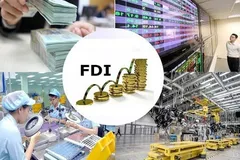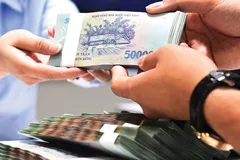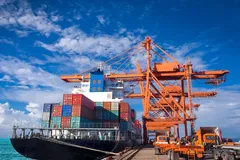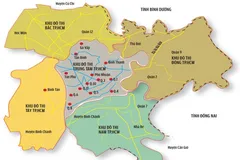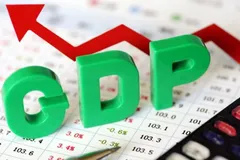
Fragility Beneath Export-Led Growth
Vietnam has set its sights on achieving at least 8% GDP growth in 2025, with the ambition of reaching double-digit expansion in the years thereafter. This aggressive trajectory is part of a broader national aspiration: to evolve from a middle-income economy into a high-income one by 2045.
Yet history offers sobering context. Vietnam has never attained a 10% annual growth rate, and the country’s pace of expansion has decelerated over time. Between 1990 and 2024, GDP grew at an average annual rate of 6.73%—robust by many measures, but insufficient to meet the lofty goals ahead.
For over three decades, Vietnam has emulated the East Asian development model—anchored in export-led growth and FDI inflows. In the early 1990s, exports of goods and services made up less than 30% of GDP. That figure surged past 50% in the 2000s and now exceeds 80%, reflecting deep integration into global value chains.
However, this strategy comes with vulnerabilities. Vietnam’s export performance hinges heavily on major markets such as the United States, the European Union, and Japan. When these economies falter, Vietnam’s own growth, employment levels, and external balance deteriorate accordingly.
Compounding these structural risks are rising global trade tensions. The United States’ increasingly protectionist stance, with retaliatory tariffs and shifting trade alliances, has intensified uncertainty. Without recalibration, Vietnam’s traditional growth model may face mounting headwinds in the years ahead.
Science, technology, and innovation—though promising—are unlikely to deliver transformational growth in the short term. As such, Vietnam must reconsider how it harnesses macroeconomic policy to navigate an increasingly volatile global environment.
The Case for Counter-Cyclical Fiscal Policy
Regardless of the overarching growth model, macroeconomic policy—both fiscal and monetary—plays a critical role in sustaining expansion and maintaining stability. When managed wisely, macroeconomic levers can stimulate output, attract investment, and foster long-term resilience. Poor policy choices or exogenous shocks, by contrast, can derail production, erode confidence, and plunge an economy into stagnation.
Vietnam’s policymakers face a dual imperative: to ignite a new phase of higher growth while avoiding the destabilising feedback loop of low expansion, rising deficits, inflationary pressures, production slowdowns, and financial sector stress.
The linchpin of such a strategy is a shift toward counter-cyclical fiscal policy—tightening during economic booms to build buffers and deploying stimulus during downturns to cushion shocks. A permanently expansionary stance, while politically expedient, risks exhausting fiscal space precisely when it is most needed.
To sustain elevated growth over the long term, Vietnam must adopt a comprehensive and forward-looking approach. This includes formulating multi-year economic plans; designing targeted tax and credit incentives for strategic sectors; improving the investment climate; and channelling greater resources into workforce development and R&D.
Infrastructure development will be key. Strategic public investment, especially in transport, energy, and digital networks, is essential not only to enhance productivity but also to crowd in private capital. However, funding such projects demands fiscal discipline and reform.
Mobilising Fiscal Space Through Reform
Vietnam must confront a core challenge: how to finance large-scale infrastructure initiatives without jeopardising macroeconomic stability. Several critical measures are required.
First, the government should significantly curb recurrent expenditure—particularly the operational costs of the state apparatus. Rationalising public sector spending is essential to free up room for capital investment.
Second, Vietnam should diversify and modernise its revenue base. One viable option is introducing a property tax on second and subsequent homes—a measure with the potential to promote equity, curb speculation, and raise non-distortionary revenue.
Another approach involves recalibrating corporate tax incentives. Rather than blanket exemptions, Vietnam could reward exporters based on their domestic value-added content—encouraging localisation, technological transfer, and deeper domestic supply chains.
Third, in the context of growing external uncertainty, personal income tax reform should be considered as a means of stimulating domestic consumption. With major export markets potentially erecting more trade barriers, boosting internal demand could provide a vital counterweight to soften the blow.
Such a reorientation would not only invigorate household spending and aggregate demand but also reduce Vietnam’s overreliance on external markets. It would place the country on a more balanced, inclusive, and resilient growth path.
Navigating the Future
Vietnam’s development over the past three decades has been remarkable. The economy has transformed from an aid-dependent, agrarian state into one of Asia’s most dynamic manufacturing hubs. But the global landscape is shifting. Geopolitical tensions, protectionist policies, and climate-related disruptions are reshaping the rules of global commerce.
To maintain momentum, Vietnam must do more than follow the path trodden by its neighbours. It must innovate, adapt, and reform. And crucially, it must adopt fiscal and macroeconomic policies that not only respond to the moment but also prepare for the future.
Counter-cyclical fiscal strategy—if credibly designed and diligently executed—offers a powerful tool to help Vietnam realise its growth ambitions while safeguarding economic stability. But it requires political will, institutional discipline, and a vision that looks beyond short-term gains.
As the country approaches a demographic peak and eyes a window of opportunity for transformation, the time to act is now.






